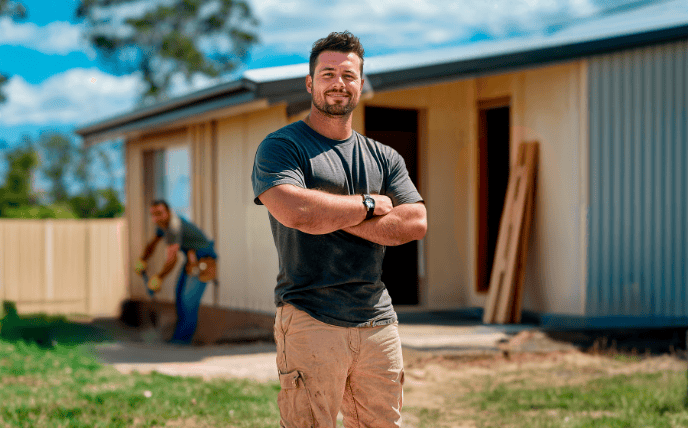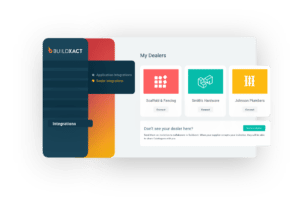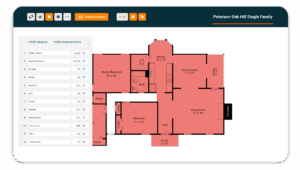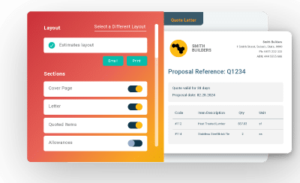Every hour that passes between an incoming roofing lead and your outgoing quote can decide whether you win the job or lose it to a faster competitor.
The risks and time lag only increase from there if you’re using traditional estimating spreadsheets and, worse still, these outdated processes are also prone to significant costing or calculation errors that then cut into your profits.
Add complex measurements and fluctuating material costs associated with roofing to the mix, and it’s easy to see why these costly mistakes and a rushed bid lose you the job and leave a negative impact on the brand and business you’ve worked so hard to build.
To avoid all-too-common situations exactly like this one, small builders turn to intelligent, automated roofing estimating software designed to both speed up and error-proof the bid process.
With dedicated features like digital takeoffs and live dealer pricing, you can generate precise, professional estimates without the manual headaches. The result is faster response times, fewer mistakes, and more of the right jobs landing in your pipeline.
In this guide, we’ll show you how to choose the best roofing estimating software for small residential businesses. Use our in-depth walkthrough of the must-have features and reviews of leading platforms to help you find the right co-pilot for your growth and profitability journey.
What are the Benefits of Roofing Estimating Software in Residential Construction?
As a busy roofing contractor, you know that a lengthy bidding process, or one that misses key items, will erode already-slim margins or even cost you the job altogether.
That’s why, according to a recent survey, more than 80% of roofing contractors have now adopted estimating software. By implication, the 20% who haven’t taken steps to “go digital” yet are still stuck playing catch-up to their tech-enhanced competitors.
Yet, it’s not just about beating the competition — staying “ahead” of the curve is just a byproduct of tech adoption. The 80% of contractors who have successfully adopted and integrated roofing estimating software are those who first did so to address the very real business challenges they faced and the benefits they gained, internally and operationally.
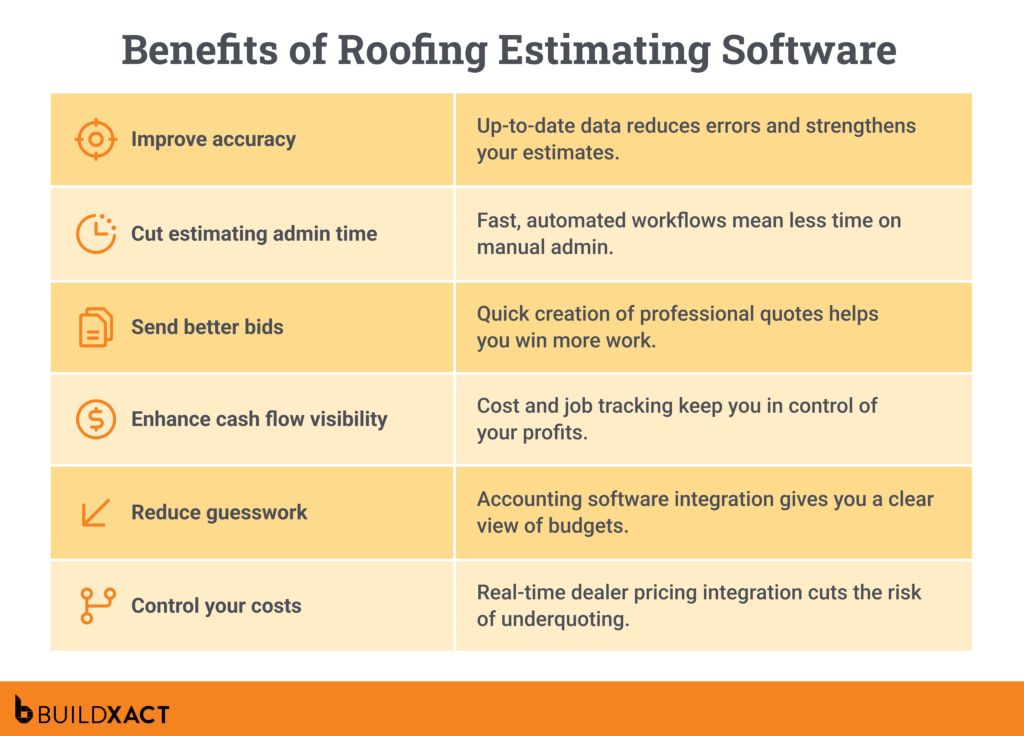
Let’s explore some of the most common issues that block roofing estimators and contractors, along with the significant gains they achieve when implementing estimating software.
Improve accuracy
The complexity of roofing measurements leaves them prone to error, and even small miscalculations can derail a bid. Digital estimating software handles complex pitches and materials with precision, reducing rework and costly mistakes.
Cut estimating admin time
Measuring roof planes by hand and juggling spreadsheets slows every bid. Automated takeoffs and calculations cut admin time and let you price jobs in minutes instead of hours.
“As construction firms aim to streamline workflows, reduce human errors, and speed up the estimation process, software solutions are becoming indispensable for enhancing productivity and ensuring cost-effective project execution.”
— Construction Estimating Software Market, Grand View Research
Send better bids
Messy bids and slow turnaround lead to losing work to faster competitors. Roofing estimating software generates professional quotes in less time, boosting your chances of winning jobs.
Enhance cash flow visibility
The sizable upfront material costs common in roofing jobs can strain cash flow. Estimating software that lets you track invoices, labor, and change orders in real-time gives you more control over profits.
Reduce guesswork
Hidden roofing costs, such as flashing and underlayment, are easy to overlook. Intelligent roofing estimating tools factor these in automatically, integrating with accounting software to ensure accurate budgets.
Control your costs
Roofing material prices can change weekly. Estimating software that connects to live dealer pricing keeps your quotes current, reducing the risk of underquoting and protecting margins.
The advantages of roofing estimating software are clear: you can quote faster, stay competitive, reduce costly mistakes, and keep tighter control of your margins. And they’re only unlocked by key features specifically built for your business, which we will break down next.
Any solution labelled “roofing software” without these essentials is simply not built for the job.
Choosing the Best Roofing Estimating Software for Small Home Builders
While roofing estimating software can offer many benefits, not every platform is built equal. Miss the features that matter most, and you’ll still struggle with slow processes, late-night admin, and estimating errors. Worse yet, you’ll have sunk thousands of dollars into a business purchase with no clear, measurable, or positive ROI.
To help you choose wisely, let’s explore the most important features for roofing contractors working in small to mid-sized residential construction.
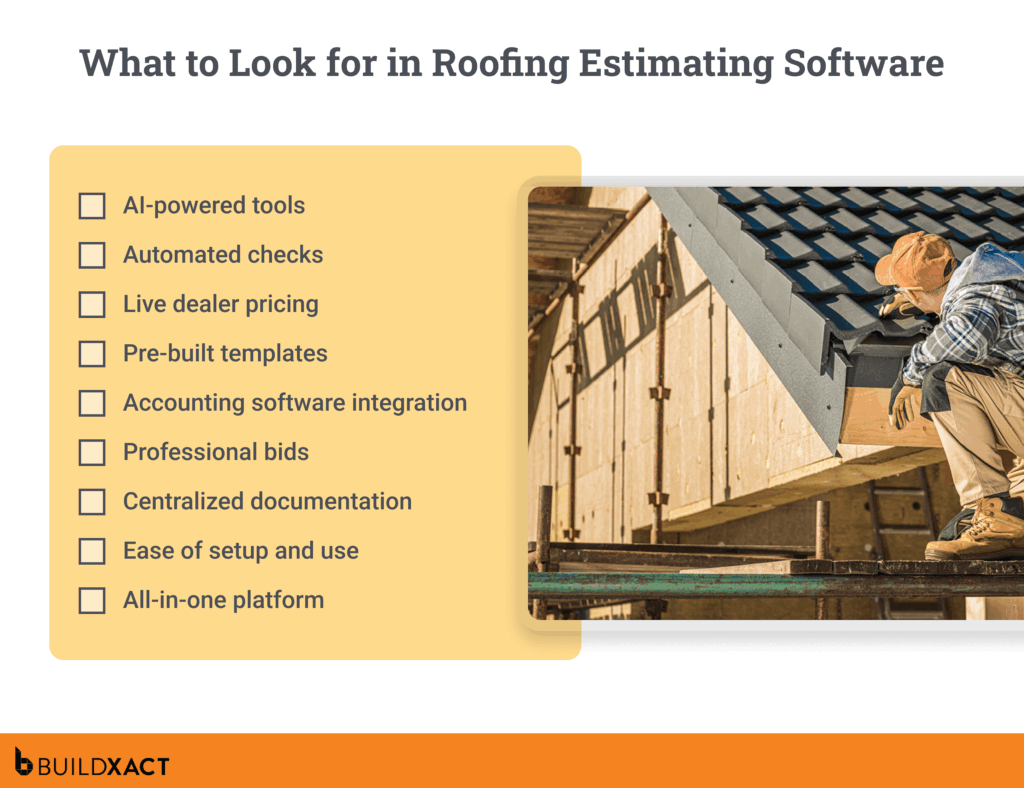
AI-powered tools
In an area of your business where speed and accuracy are key, AI-driven estimating tools can help you cut admin time, minimize errors, and reduce lost jobs due to slow or inaccurate bids.
“With rapid AI takeoffs, estimators can quickly generate cost estimates and even iterate multiple scenarios (e.g. using different materials) to identify the most cost-effective approach.”
— The 2025 Construction Tech Landscape, Slate.AI
Automated measurements and error checks
Manually measuring roof planes is slow and prone to error, especially with complex pitches and waste factors. Automated error checks flag missed items to avoid expensive mistakes.
Live dealer pricing
Real-time links to dealer price lists and regional labor rates keep estimates current and reduce underquoting for roofing jobs where shingle, tile, and metal costs fluctuate frequently.
Pre-built templates
Using reusable templates, quickly build estimates for standard roofing jobs, such as re-shingling or metal installations, with processes that reflect industry best practices to keep bids consistent and margins predictable.
Accounting software integration
Direct sync with your accounting system pulls income and expenses directly into your roofing estimates, eliminating double entry and providing clearer visibility into your financials.
Professional bids
Polished, branded proposals generated directly from your takeoff data help you bid faster, build credibility, and stand out even against larger competitors.
Centralized documentation
Keep jobs moving smoothly with a single hub for all your PDFs, roof plans, and dealer files, which helps avoid version chaos and project disruption.
Ease of setup and use
Choosing easy-to-use estimating software with a straightforward setup and onboarding process means you won’t have to spend extra time learning a new platform.
“The learning curve associated with new software and the potential resistance from employees who are accustomed to manual methods can delay the adoption of estimating software.”
— Construction Estimating Software Market, Data Horizon Research
Unified platform with extensible integrations
An end-to-end platform that combines estimating with other critical roofing tasks — like ordering, scheduling, and job management — cuts the time you spend juggling multiple tools across different software. You’ll also be able to extend its use with accounting, scheduling, and design or drafting software integrations, forming a complete ecosystem of functionality.
Choosing roofing estimating software with the right features helps solve common roofing headaches like miscalculated takeoffs, outdated material costs, and scattered job details.
Next, we’ll compare some of the leading roofing estimating platforms on the market so that you can make an informed decision.
Roofing Estimating Software: Comparison Guide for Residential Builders
As a roofing contractor, the software you choose can make a significant difference to how efficiently you run jobs and how competitive your bids are. As the Better Business Bureau notes in its industry report, “One thing is clear: roofing companies that invest in technology are more likely to be successful.”
To help you make the best choice, we’ve compared some of the top roofing estimating software tools and shared our verdict below.
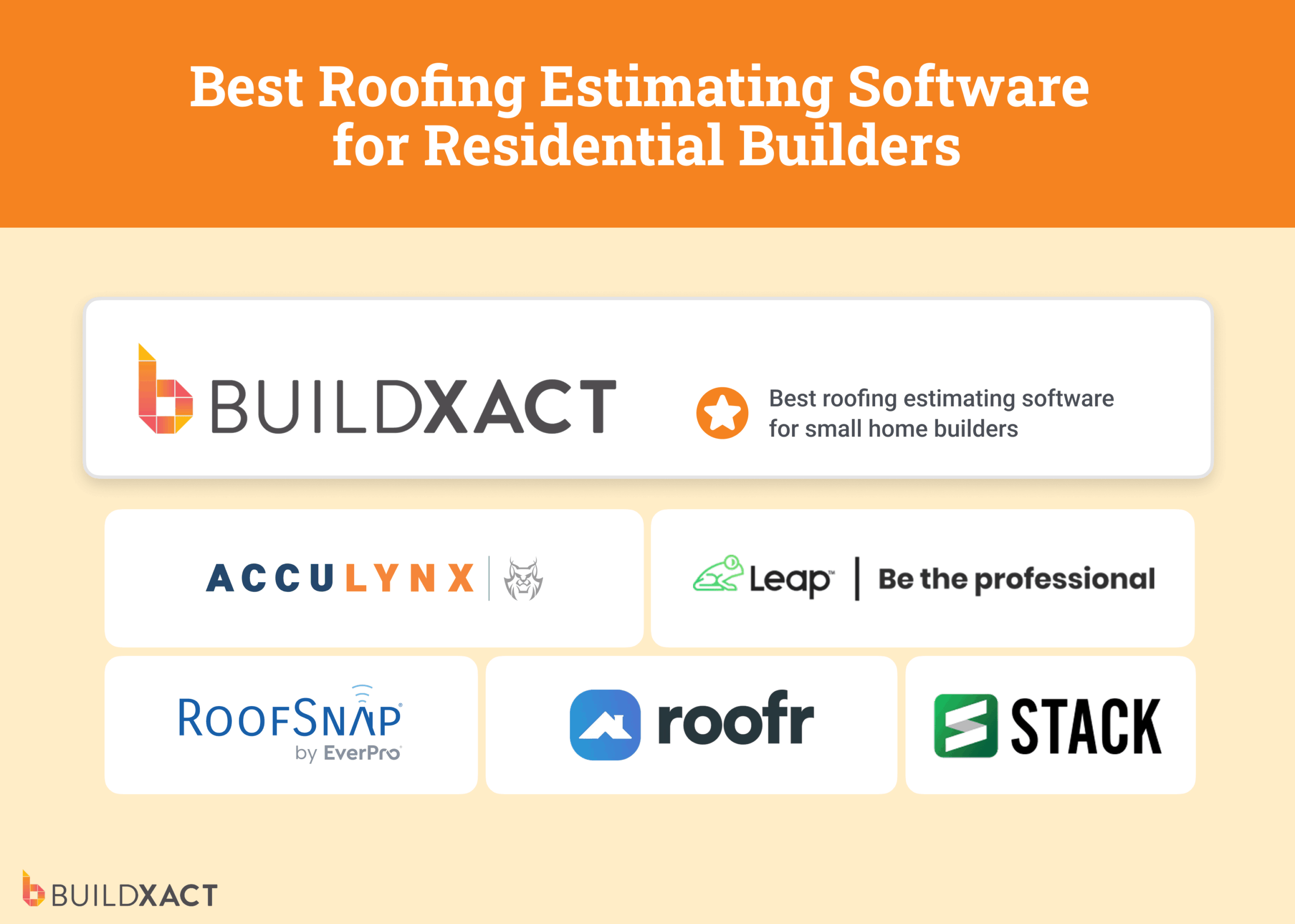
Buildxact
Buildxact is an end-to-end construction management platform purpose-built for small to mid-sized residential builders. It combines estimating, takeoffs, scheduling, cost tracking, and client communication in a single, cloud-based system designed to streamline day-to-day construction workflows.
For contractors specializing in roofing projects, Buildxact’s roofing estimating software stands out, packing all the essential features you’ll need to streamline operations and improve profit margins.
Buildxact’s automated, AI-driven takeoffs cut measuring time in half, while live dealer pricing ensures quotes reflect current metal costs. The platform also generates professional, branded proposals directly from your takeoff data, helping you deliver accurate bids quickly and win more roofing jobs.
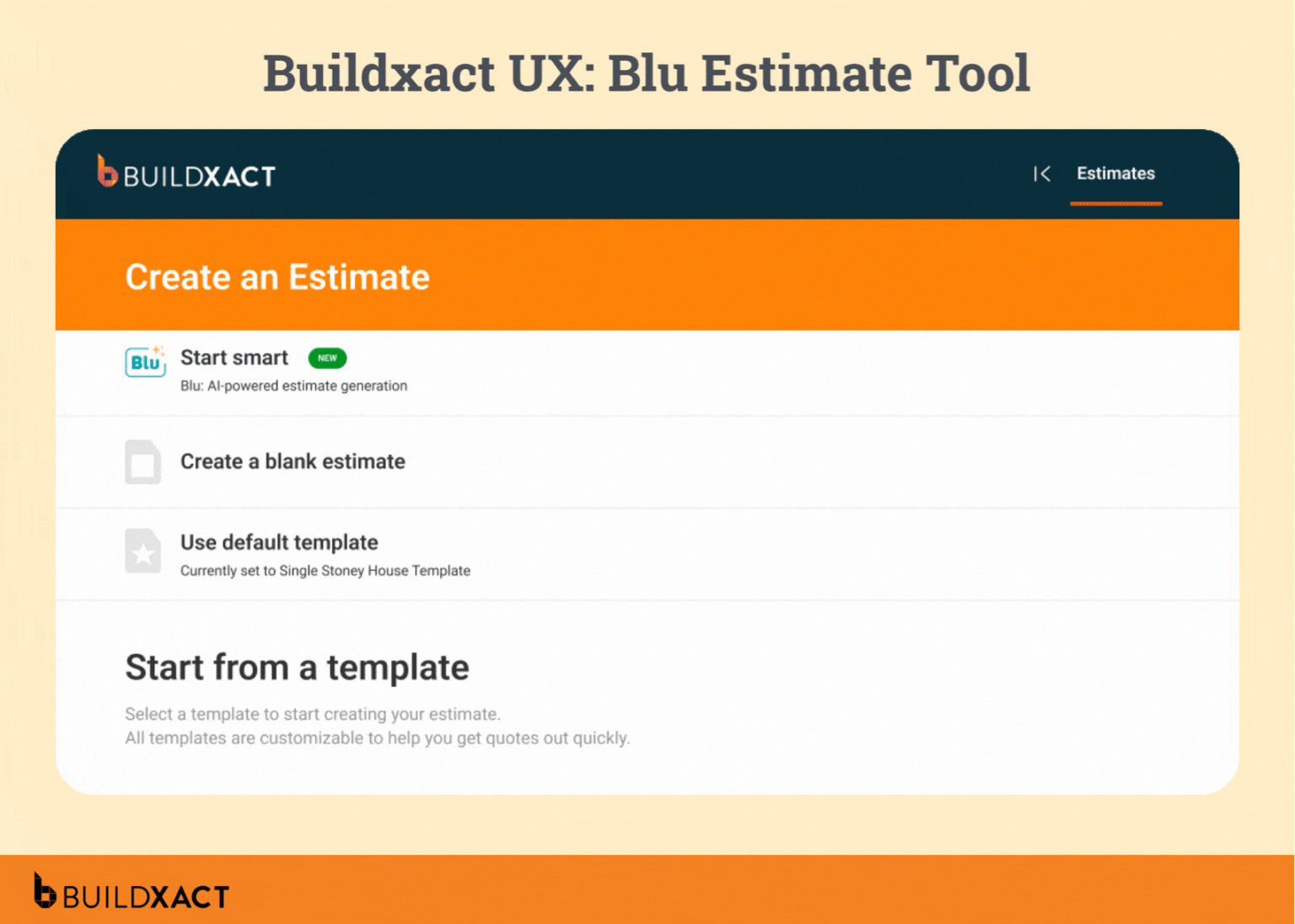
What are the benefits of Buildxact’s roofing estimating software?
AI-powered estimating with Blu
Blu, Buildxact’s powerful digital estimating assistant, helps contractors complete roofing estimates up to 7x faster. With built-in checks that flag missed items, such as underlayment or flashing, it reduces costly errors and helps ensure every bid reflects the full scope of work.
Point-and-click roof takeoffs
Instead of climbing ladders with a tape measure or juggling paper plans, Buildxact users can digitally trace roof sections. Complex angles and waste factors are calculated automatically, enhancing precision and reducing takeoff time by up to 50% compared to manual methods.
Live dealer pricing
With the price of roofing materials such as shingles, tiles, and flashing changing frequently, Buildxact’s real-time connection to supplier pricing and regional labor rates keeps bids up-to-date. Estimates automatically update with dealer price lists, reducing the risk of underquoting and protecting margins.
Reusable templates for repeat work
Saved assemblies and templates cut estimate prep time by 30%. For repeatable roofing jobs, such as tear-offs, re-roofs, or standard repairs, contractors can reuse these templates to maintain consistent pricing and expedite the quoting process.
Seamless integrations that expand your roofing tech stack
Buildxact integrates seamlessly with accounting platforms like Xero and QuickBooks, as well as team scheduling tools like Deputy, creating a connected ecosystem without requiring a full tech stack overhaul.
Data flows automatically from takeoff through invoicing, reducing double entry and admin errors. And with the Rendr integration, roofing contractors can even generate site-ready digital plans from a mobile device — no desktop setup required.
Drawbacks and limitations
As Buildxact is designed around residential construction, it doesn’t cater to the more complex requirements of large-scale commercial roofing. Firms dealing with specialized compliance needs, multi-team coordination, or highly tailored workflows may find the platform less suitable.
What people say about Buildxact
For builder Ron Marcella III, moving away from dozens of Excel spreadsheets to Buildxact has been transformative.
“The key for builders is focus and organization. Now, with Buildxact, I don’t have to worry about misplacing anything and having to make phone calls again to figure it out. It definitely keeps me organized.”
With every estimate, note, and bid accessible in a single browser-based system, Ron can check on jobs from anywhere with an internet connection. The shift has already saved him hours on routine tasks, giving him a clearer picture of his projects — and more time to enjoy life outside of work.
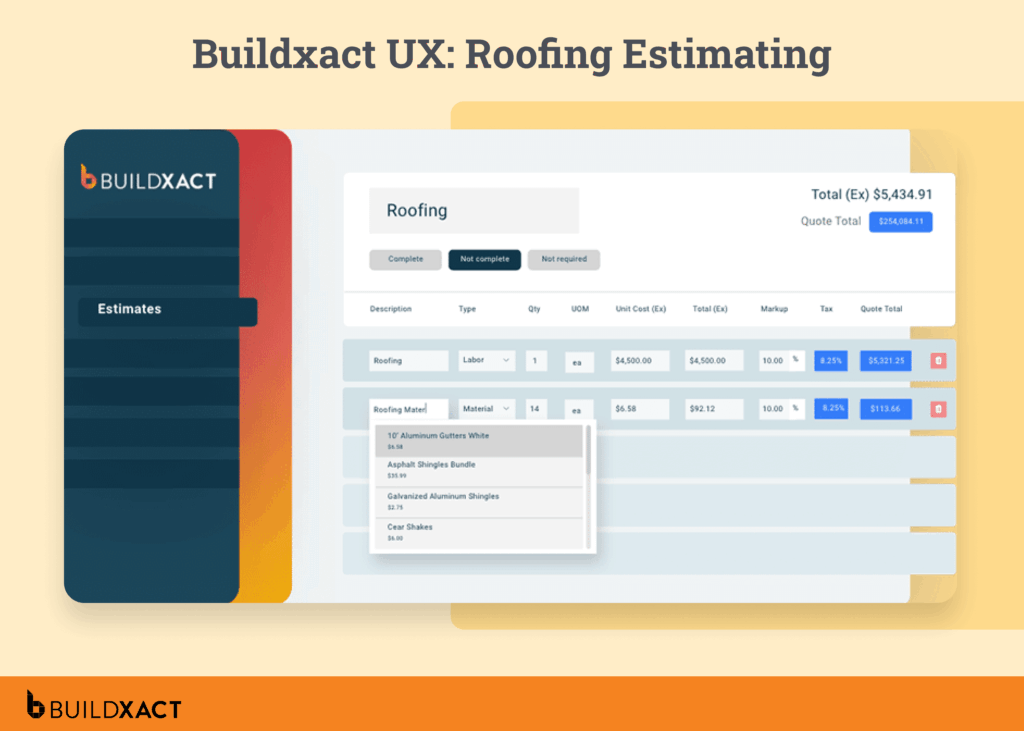
Who is Buildxact best for?
Buildxact is well-suited to small and mid-sized residential roofing companies that want to simplify the way they measure, price, and quote jobs. Busy contractors focused on speeding up estimates and improving accuracy to secure more projects will see the most value.
What do we score Buildxact roofing estimating software?
- SMB focus: 5/5
- Dealer pricing integration: 5/5
- AI and automation: 5/5
- Ease of setup and use: 5/5
RoofSnap
RoofSnap is a roofing-focused measurement and estimating platform that turns aerial imagery into roof diagrams, sketches, and proposals. Designed for roofing contractors, it helps simplify the estimating process by linking measurement results directly to estimates.
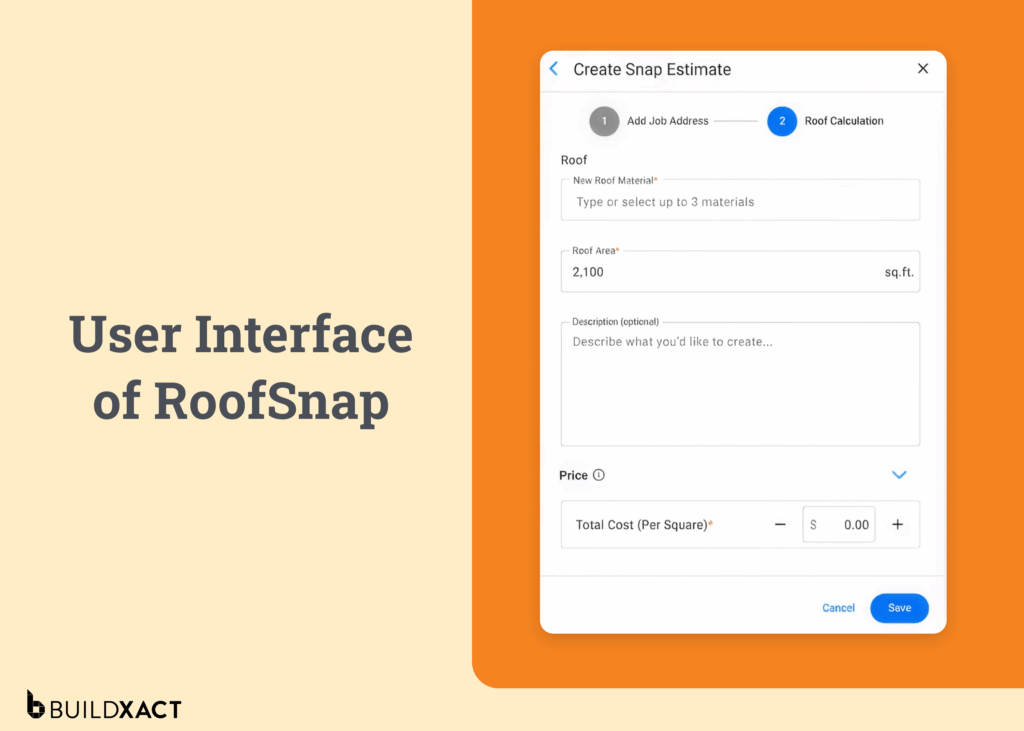
Benefits of RoofSnap
RoofSnap’s image-based workflow is easy to use, allowing roof sketches and measurements to be created directly from aerial or drone imagery. It also offers strong integrations with tools like QuickBooks, Xactimate, and EagleView, helping contractors centralize estimating and project data across platforms they already use.
Drawbacks and limitations
As RoofSnap is designed mainly for roof measuring and estimating, it doesn’t cover broader project management needs. Contractors who simplify their workflows with integrated features, such as crew scheduling, CRM tools, or job tracking, may find gaps in RoofSnap’s functionality.
Who is RoofSnap best for?
RoofSnap is a good fit for small roofing contractors who want a straightforward tool for sketching and estimating from aerial or drone imagery. It’s less suitable for small to mid-sized residential firms that require a comprehensive, all-in-one platform to manage projects, scheduling, and client communication.
What do we score RoofSnap roofing estimating software?
- SMB focus: 4/5
- Dealer pricing integration: 3/5
- AI and automation: 3/5
- Ease of setup and use: 4/5
Roofr
Roofr is an all-in-one roofing software platform built specifically for contractors, offering tools for tasks like measurements, proposals, invoicing, and ordering. For estimating and takeoffs, Roofr converts aerial imagery into roof reports, generating instant estimates.
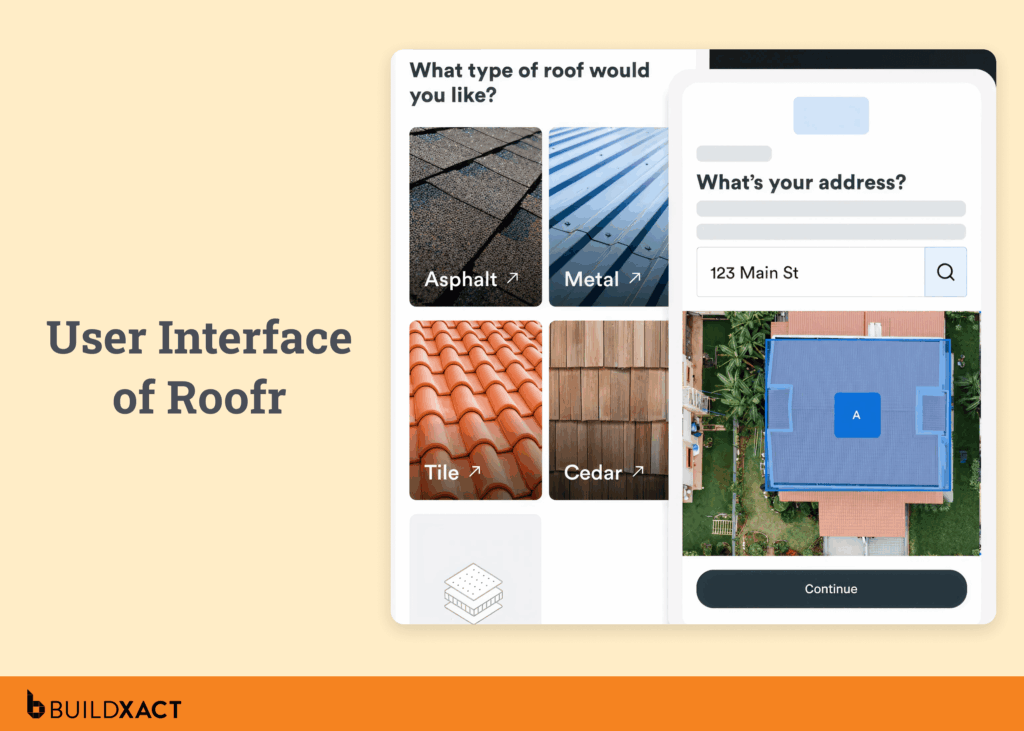
Benefits of Roofr
Roofr’s simple, intuitive design makes it easy for contractors to get started quickly, with a focus on streamlined estimating and proposal tools that don’t require a steep learning curve to adopt and use.
Drawbacks and limitations
Roofr has limited mobile functionality, as the platform is primarily built for desktop use. Contractors who don’t want to be tied to their computer to manage estimates and proposals will find this restrictive.
Who is Roofr best for?
Roofr is best suited to residential and commercial roofing contractors who want a simple, desktop-based tool for creating estimates and proposals. It’s a suitable option for teams that don’t require more robust construction project management or advanced mobile functionality for site management.
What do we score Roofr roofing estimating software?
- SMB focus: 3/5
- Dealer pricing integration: 4/5
- AI and automation: 4/5
- Ease of setup and use: 4/5
STACK
STACK Construction Technologies is a cloud-based preconstruction platform specializing in digital takeoffs and estimating for contractors of all sizes. It offers advanced measurement tools, cost estimating, and collaboration features, giving builders a way to streamline bidding and improve accuracy before projects move to the construction phase.
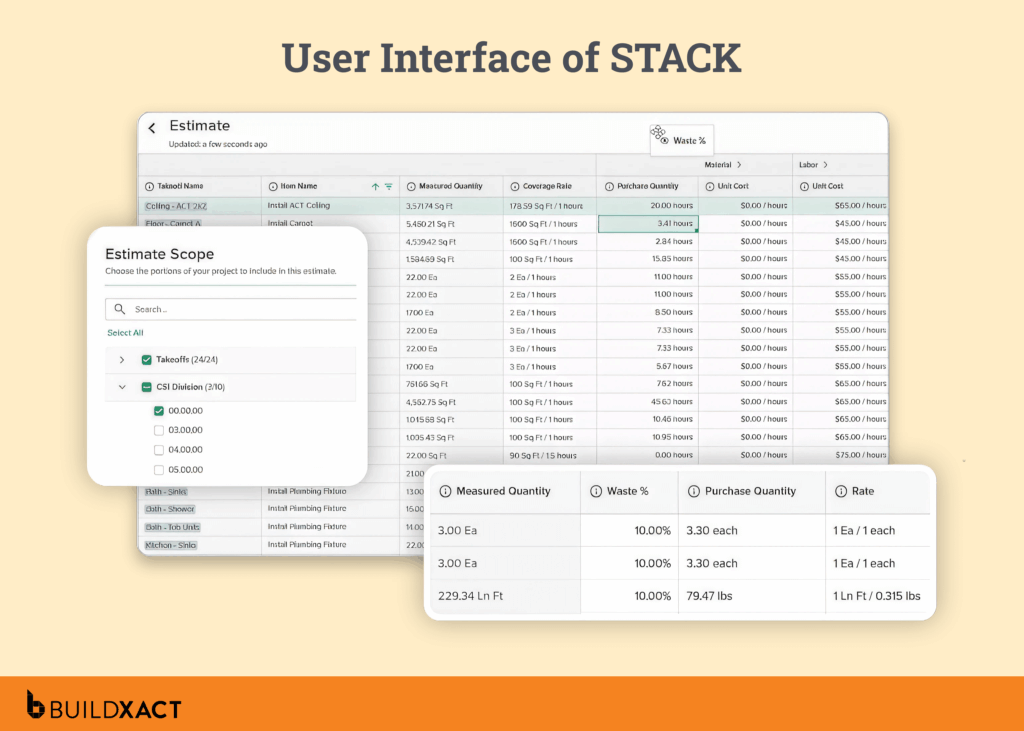
Benefits of STACK
STACK’s advanced automation is a huge plus for roofing contractors, improving speed and accuracy in their takeoff and estimating processes. Additionally, the platform provides robust mobile tools that enable easy management of estimates and bids from any location.
Drawbacks and limitations
STACK’s user-based pricing model can make it expensive for small to mid-sized firms looking to scale, as costs can rise quickly as teams grow and more licenses are added.
Who is STACK best for?
STACK is a good choice for contractors focused on preconstruction, particularly in commercial projects where advanced takeoffs and estimates drive bidding. Small to mid-sized landscaping firms may find the platform’s pricing model and commercial focus problematic.
What do we score STACK roofing estimating software?
- SMB focus: 2/5
- Dealer pricing integration: 5/5
- AI and automation: 4/5
- Ease of setup and use: 3/5
AccuLynx
AccuLynx is a roofing-specific software platform that combines estimating, CRM, scheduling, and job management. It’s designed to help roofing contractors organize leads, track production, and manage materials and finances from a single location.
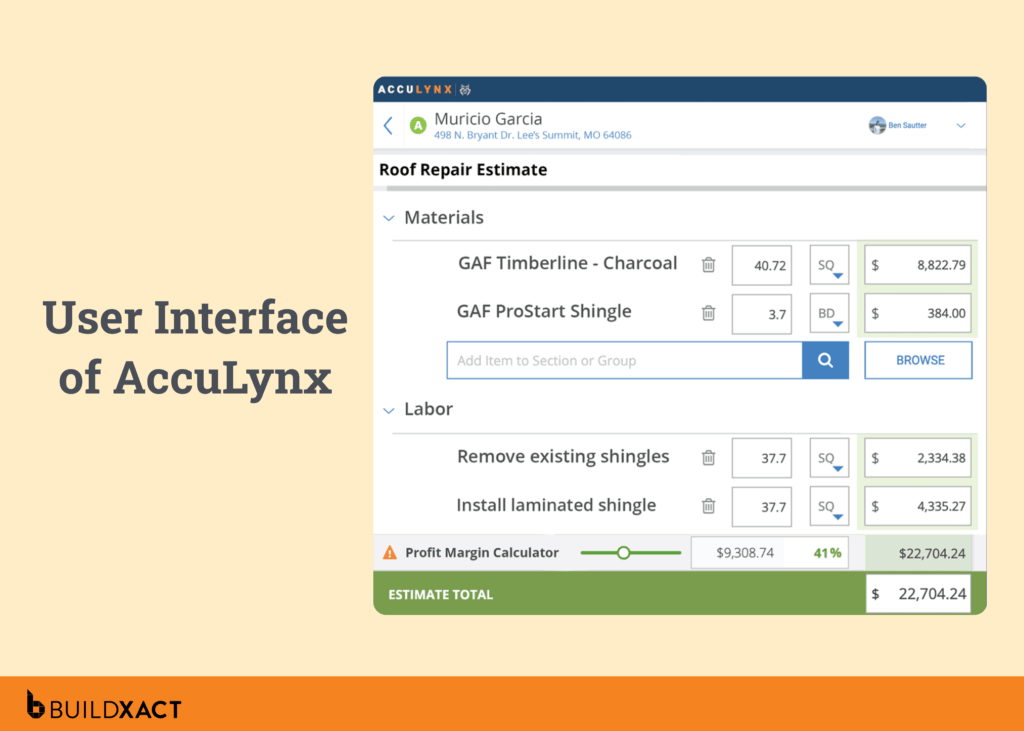
Benefits of AccuLynx
With a built-in CRM, AccuLynx excels at helping contractors track leads and customer interactions. It also integrates with accounting tools like QuickBooks and Xero, adding transparency to financial processes.
Drawbacks and limitations
AccuLynx offers a wide range of features, but the platform can be complex for new users. The steep learning curve may be a drawback for smaller contractors who need a simpler setup that allows them to see value fast.
Who is AccuLynx best for?
AccuLynx is best suited to larger roofing companies and commercial construction firms that need a comprehensive system to manage sales, production, and operations. Its complex feature set and lengthy onboarding process make it less suitable for small to mid-sized residential businesses.
What do we score AccuLynx roofing estimating software?
- SMB focus: 2/5
- Dealer pricing integration: 5/5
- AI and automation: 4/5
- Ease of setup and use: 1/5
Leap
Leap is a roofing and home improvement software platform that combines estimating, contracts, production management, and payment processing in one system. It includes tools for managing leads, organizing project documents, and coordinating workflows.
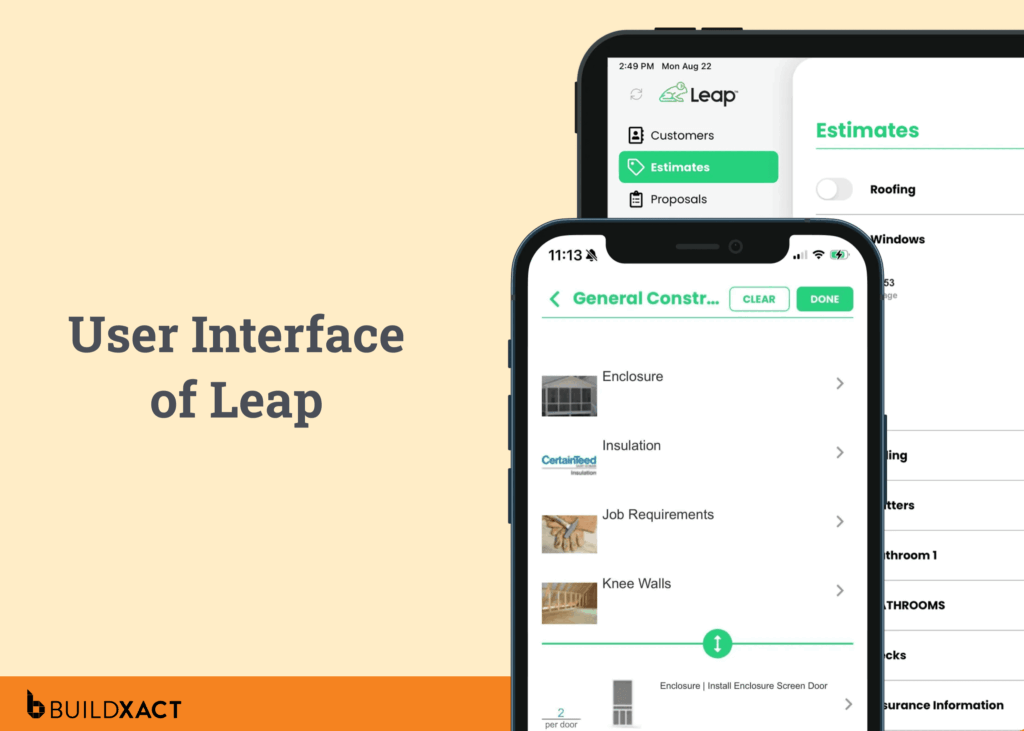
Benefits of Leap
Leap provides strong project management tools along with centralized document storage, helping contractors keep jobs organized. It also supports BIM modeling features, which can improve accuracy and visibility across projects.
Drawbacks and limitations
Leap’s broad feature set can make onboarding challenging for new users. Many contractors report a steep learning curve and extensive training requirements to utilize the platform effectively.
Who is Leap best for?
Leap is best suited to commercial contractors working across the home services industry, including roofing, kitchen, and bathroom remodeling. Its wide range of features makes it more appropriate for firms managing multiple service lines rather than small residential-focused businesses.
What do we score Leap roofing estimating software?
- SMB focus: 2/5
- Dealer pricing integration: 4.5/5
- AI and automation: 4/5
- Ease of setup and use: 1/5
Equipped with these platform reviews, you can narrow in on the roofing estimating software that fits your business best. A purpose-built platform for small to mid-sized residential construction will help you streamline administration, eliminate manual estimating errors, and send competitive, professional bids quickly.
Roofing Estimating Software: FAQs
Which software is most commonly used for estimating?
The most widely used estimating platforms are those that provide digital takeoffs, integrated pricing, and simple workflows, making them suitable across a broad range of trades.
What is the best roofing estimating software for small contractors?
Small contractors benefit most from estimating tools that offer features such as automated measurements, AI-powered processes, live dealer pricing, and easy proposal generation, which help save time and reduce errors.
Is roofing estimating software easy to use?
Tools with advanced feature sets or deep customization, particularly for commercial projects, may have steeper learning curves. Platforms built for small to mid-sized residential workflows are easier to set up and use.
Send Better Bids in a Fraction of the Time, With AI-Powered Estimating
For roofing contractors, estimates are commonly slowed by error-prone manual takeoffs, scattered spreadsheets, and material prices that shift before the job begins. In addition to making estimating an inefficient process that consumes your evenings, these challenges also put your margins at risk.
With Buildxact, residential-focused features such as automated measurements, AI-powered error checks, and live supplier pricing reduce admin time and prevent mistakes from eroding your profits. And with professional proposals generated quickly and accurately, you’ll have more confidence in every bid and win more of the right work..
If you’re ready to speed up and streamline your roofing estimating, start your free trial today or book an interactive demo.


